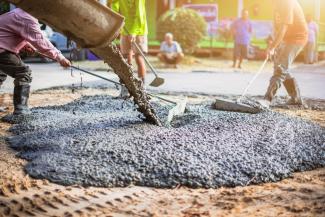An NETL-developed technology improves the strength of cement by up to 30% and enhances durability by 60% using nanostructured carbon additives made from charred coal fine waste.
“Cement composites, including cement paste, mortar and concrete, are some of the most widely used construction materials in the world,” NETL’s Yuan Gao explained. “However, their quasi-brittle nature, susceptibility to cracking, low toughness and low tensile strength have been identified as the main characteristics that result in poor durability and high maintenance costs.”
NETL’s Congjun Wang added that traditionally, attempts have been made to enhance the strength and durability of cement by incorporating steel rebars and macro/microfibers, chemical mixtures, silica fume or reducing the water to binder ratio.
“In the past decade, the use of nanomaterials in cement composites and graphite-based carbon additives received considerable attention,” Wang said. “Nanomaterials have the potential to control nanoscale cracks, which can prevent their growth and formation of micro-, or even larger-scale, defects. However, those nanomaterials have been rarely used in the construction industry because of high material costs and limited data on performance and durability. In our study, domestic coal was used to fabricate low-cost carbon nanomaterials that can be used economically in cement formulations.”
The technology was described in a peer-reviewed paper titled “High Performance Cementitious Composites Containing Nanostructured Carbon Additives Made from Charred Coal Fines.” The paper was authored by NETL’s Yuan Gao, Viet Hung Pham, Jennifer Weidman, Ki-Joong Kim, Richard E. Spaulding, Wang and Matranga. The paper was published in Nature’s Scientific Reports, the 5th most cited journal in the world.
Coal is a carbon-rich feedstock and has been used to produce carbon nanomaterials. According to the paper, select coal types could be used for large-scale production of carbon nanomaterials using simple mechanical methods and the abundance and low cost of coal makes it suitable for the large markets associated with manufacturing carbon-enhanced composites for construction applications.
The small, nanostructured carbon converted from charred coal fines improve the strength and microstructure of the cement material.
Carbon-based nanomaterials have an ability to impart unique mechanical, electrical, thermal, and optical properties to cement composites. The research indicated that a range of chemical and physical processing approaches can control the size and chemical functionalization of the carbon nanomaterial to improve cement’s mechanical properties and durability.
When incorporated into cement paste, the mechanical properties, including compressive and flexural strength and durability were measured. Three carbon nanomaterials — carbon quantum dots, non-oxidized carbon nanoflakes, and oxidized carbon nanoflakes — were applied in cement or concrete samples for their reinforcing effect on mechanical properties and durability.
All three types of coal-derived carbon nanomaterials enhanced the cement’s compressive and flexural strength and reduced the gas permeability, gas porosity and chloride ion penetration depth in cement samples. In addition, both the compressive and flexural strength of concrete were improved with the addition of the three carbon nanomaterials.
“In fact, the improvement of mechanical properties and durability of cement composites using coal-derived carbon additives were comparable with, or better than, those reported in with graphite-based carbon additives,” NETL’s Christopher Matranga, the project lead, said. “The low cost and wide abundance of coal feedstocks and high production yield of additives from them could make large-scale deployment of this technology more feasible, leading to not only performance and cost advantages, but also environmental benefits as currently 8% of carbon emission is from cement industry.”
Use of the charred coal fine waste option to make the additives for concrete may be more economical than graphite-based carbon additives because graphite demand will increase in coming years to support battery markets.
NETL is a DOE national laboratory that drives innovation and delivers solutions for an environmentally sustainable and prosperous energy future. By using its world-class talent and research facilities, NETL is ensuring affordable, abundant, and reliable energy that drives a robust economy and national security, while developing technologies to manage carbon across the full life cycle, enabling environmental sustainability for all Americans.




